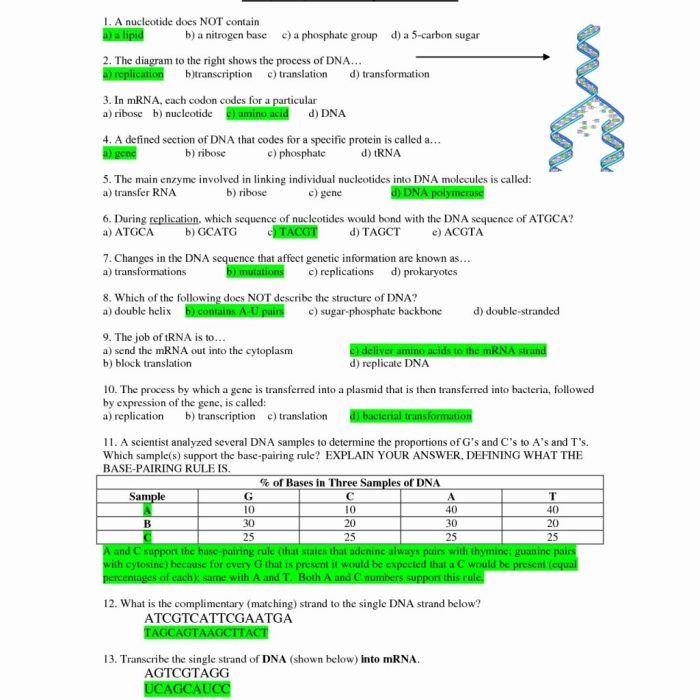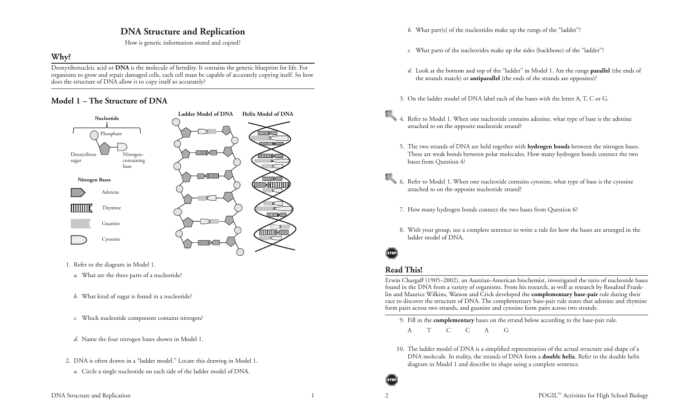Dna worksheet structure of dna and replication – Embark on an enlightening journey with our DNA worksheet, meticulously crafted to unravel the intricate structure and fascinating replication process of DNA, the blueprint of life. This comprehensive guide delves into the molecular foundations of genetics, providing a profound understanding of the fundamental principles that govern the inheritance and expression of traits.
DNA Structure: Dna Worksheet Structure Of Dna And Replication
DNA, or deoxyribonucleic acid, is a molecule that contains the genetic instructions for an organism. It is made up of two long chains of nucleotides that are twisted around each other to form a double helix. Each nucleotide is composed of a sugar molecule, a phosphate group, and a nitrogenous base.
There are four different types of nitrogenous bases: adenine (A), thymine (T), cytosine (C), and guanine (G). A always pairs with T, and C always pairs with G. This pairing is what gives DNA its double helix structure.
Components of DNA
- Nucleotides: The building blocks of DNA. Each nucleotide consists of a sugar molecule, a phosphate group, and a nitrogenous base.
- Bases: The nitrogenous bases are adenine (A), thymine (T), cytosine (C), and guanine (G). A always pairs with T, and C always pairs with G.
- Deoxyribose sugar: The sugar molecule in DNA is deoxyribose.
- Phosphate groups: The phosphate groups give DNA its negative charge.
Illustration of the DNA Double Helix
The DNA double helix is a twisted ladder-like structure. The sides of the ladder are made up of the deoxyribose sugar and phosphate groups, and the rungs of the ladder are made up of the nitrogenous bases. The major groove of the DNA double helix is wider than the minor groove, and it is the major groove that is recognized by proteins that bind to DNA.
DNA Replication
DNA replication is the process by which DNA makes a copy of itself. This process is essential for cell division, as each new cell needs its own copy of the DNA.
Steps of DNA Replication
- Initiation:DNA replication begins at specific locations on the DNA molecule called origins of replication. At these locations, the DNA double helix unwinds and the two strands separate.
- Elongation:Once the DNA strands have separated, DNA polymerase, an enzyme, begins to add nucleotides to each strand. DNA polymerase can only add nucleotides to the 3′ end of a DNA strand, so it must read the template strand in the 3′ to 5′ direction.
- Termination:DNA replication continues until the entire DNA molecule has been copied. Once the replication is complete, the two new DNA molecules are identical to each other and to the original DNA molecule.
Enzymes Involved in DNA Replication
- Helicase:Helicase is an enzyme that unwinds the DNA double helix.
- DNA polymerase:DNA polymerase is an enzyme that adds nucleotides to the 3′ end of a DNA strand.
- Ligase:Ligase is an enzyme that joins the newly synthesized DNA strands together.
DNA Replication Errors and Repair

DNA replication is a very accurate process, but errors can sometimes occur. These errors can be caused by a variety of factors, including radiation, chemicals, and errors in the DNA polymerase enzyme.
Types of DNA Replication Errors
- Base substitutions:A base substitution is an error in which one base is replaced by another base.
- Insertions:An insertion is an error in which one or more bases are added to the DNA strand.
- Deletions:A deletion is an error in which one or more bases are removed from the DNA strand.
DNA Repair Mechanisms
Cells have a number of mechanisms to repair DNA replication errors. These mechanisms include:
- Mismatch repair:Mismatch repair is a process that corrects errors in which one base is replaced by another base.
- Nucleotide excision repair:Nucleotide excision repair is a process that removes damaged bases from the DNA strand.
Genetic Diseases Caused by DNA Replication Errors
DNA replication errors can cause a variety of genetic diseases. These diseases include:
- Sickle cell anemia:Sickle cell anemia is a genetic disease caused by a base substitution in the beta-globin gene. This mutation results in the production of a defective form of hemoglobin, which causes red blood cells to become sickle-shaped.
- Cystic fibrosis:Cystic fibrosis is a genetic disease caused by a deletion in the CFTR gene. This mutation results in the production of a defective form of the CFTR protein, which leads to the buildup of mucus in the lungs and other organs.
Applications of DNA Technology
DNA technology has a wide range of applications in fields such as medicine, forensics, and biotechnology.
Applications in Medicine
- Genetic testing:DNA testing can be used to diagnose genetic diseases, such as sickle cell anemia and cystic fibrosis.
- Gene therapy:Gene therapy is a technique that uses DNA to treat genetic diseases. Gene therapy involves replacing a defective gene with a healthy gene.
Applications in Forensics
- DNA fingerprinting:DNA fingerprinting is a technique that uses DNA to identify individuals. DNA fingerprinting is used in criminal investigations and paternity testing.
Applications in Biotechnology
- Genetic engineering:Genetic engineering is a technique that uses DNA to modify organisms. Genetic engineering is used to create new crops, pharmaceuticals, and other products.
Ethical Implications of DNA Technology, Dna worksheet structure of dna and replication
DNA technology has a number of ethical implications. These implications include:
- Privacy concerns:DNA testing can reveal a lot of information about an individual, including their health risks and genetic predispositions. This information could be used to discriminate against individuals.
- Designer babies:Genetic engineering could be used to create designer babies with specific traits. This raises concerns about the potential for eugenics.
Essential Questionnaire
What are the key components of DNA?
DNA comprises nucleotides, each consisting of a nitrogenous base (adenine, thymine, cytosine, or guanine), a deoxyribose sugar molecule, and a phosphate group.
How does DNA replication occur?
DNA replication involves unwinding the double helix, separating the strands, and synthesizing new complementary strands using DNA polymerase.
What are the potential consequences of DNA replication errors?
DNA replication errors can lead to mutations, which may cause genetic diseases or contribute to cancer development.
